Cactus is a succulent, that is, it can accumulate water and fully exist in an arid climate. At home, he has a huge advantage over other plants, since he does not need to be watered often. However, a young grower should know how to care for a cactus so that this plant does not get sick or die.
Material Content:
Varieties of cacti
There are many varieties of homemade cactus that differ in growth rate, the shape of the main trunk, flowering time and even the quality of thorns. In some species, with proper care, beautiful flowers appear on the top of the head, so that they can effectively decorate almost any interior.

Some varieties of cactus:
- Aporocactus is wattled. It is represented by thin drooping stems, the thickness of which does not exceed 1 cm. It blooms in spring. The flowers have an elongated shape and a rich pink color. Easy to grow, looks good in hanging baskets.
- Astrophytum Capricorn. It has a rounded shape and a dark green color with silver splashes. As you grow older, it becomes more elongated. The spines are long, curved. The main feature is the appearance of a pale yellow daisy-shaped flower on the top of the head.
- Cereus Peruvian. In height, this cactus can reach 0.5-1 m. The stem is uneven, with many branches throughout the growth. Blooms in long flowers.
- Chametereus Silvestri. The stems are thin, multiple. During flowering, bright red flowers bloom on them, which looks very impressive.
- Kleistocactus Strauss. A distinctive feature of this type of succulent is its silver color.The shade gives it a large number of white villi and spikes over the entire surface of the stem.
- Echinocereus crest. A dark green cactus with small thorns, which in an adult state does not reach a height of more than 25 cm. It blooms with bright pink fragrant flowers.
- Gimnokalitsium Mikhanovich. It is a bright colored stalk that is grafted onto a green cactus stock. This variety looks original and very bright.
- Cactus Mammillaria Bokasskaya. A plant with silver spines, which has an oval shape. It blooms with delicate flowers that are located around the top of the stem.
- Notocactus Otto. It has a cylindrical stem and very dense spines. Blooms with a large chamomile flower at the base.
- The prickly pear is small-haired. A cactus looks like a lot of flattened blades sprouting from each other. Spines are small, white or red.
Succulents do not always bloom, but only with proper care. If no flowers are observed on the plant, then the conditions of detention are not fully met.
How to care for a cactus: basic rules
To properly care for a cactus, you need to know several basic principles and always adhere to them. A plant should be created as comfortable as possible for its proper growth and development.
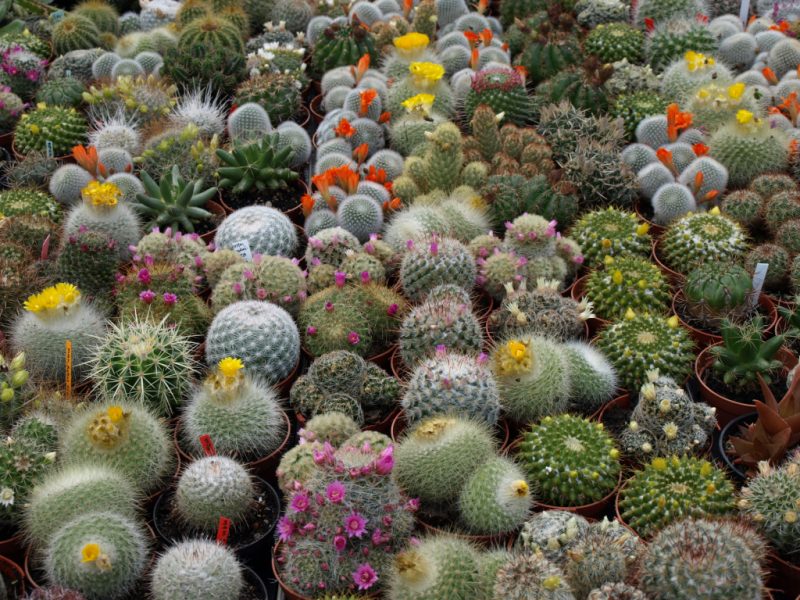
What you need to know before buying a succulent:
- the cactus grows periodically, growth retardation and stem extension are quite pronounced;
- the plant does not tolerate excess water in the soil, because of which the root system can rot;
- during the growth period for a flower pot it is better to choose a place carefully lit by sunlight;
- in the winter season, the plant requires lower air temperature and shading;
- Before buying it, you need to carefully inspect for the presence of diseases, pests on the surface and evaluate its appearance;
- To properly care for a cactus, you need to know its appearance exactly.
However, in addition to these rules, there are many more nuances that must be taken into account in caring for succulents. It is required to choose the right pot and substrate, to ensure optimal air temperature, watering and fertilizer.
Optimal plant conditions
Cacti in the house require no less attention than any other plant. First of all, they need to choose a suitable place that will meet all the requirements put forward by the plant.
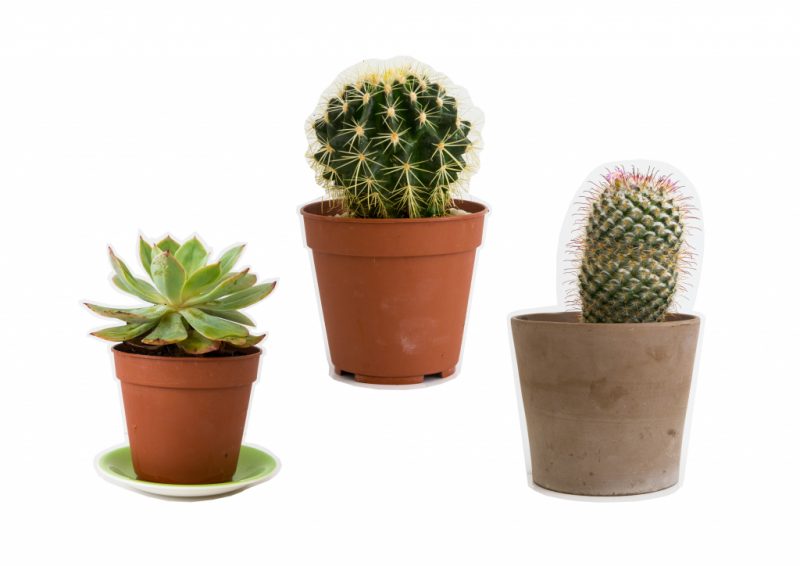
- With great care, it is recommended that you approach the purchase of a succulent pot. Its volumes should not exceed the diameter of the root system by more than 1 cm. Those cacti that have an elongated rhizome need elongated dishes. If the roots of the plant do not go deeper, it is better to choose a flat pot.
- The cactus should be located on the windowsill from the southwest side - there should be plenty of sunlight. Some species can tolerate shade, but most plants die from this.
- Also, a succulent needs a large amount of fresh air for full growth. It will need to be moistened in the hot season.
- The room temperature is suitable for cacti, but in winter they need to be kept cool.
How to water at different times of the year?
You need to water the plant correctly, since its appearance directly depends on it. In the summer, fluid should enter the soil more often than in winter.
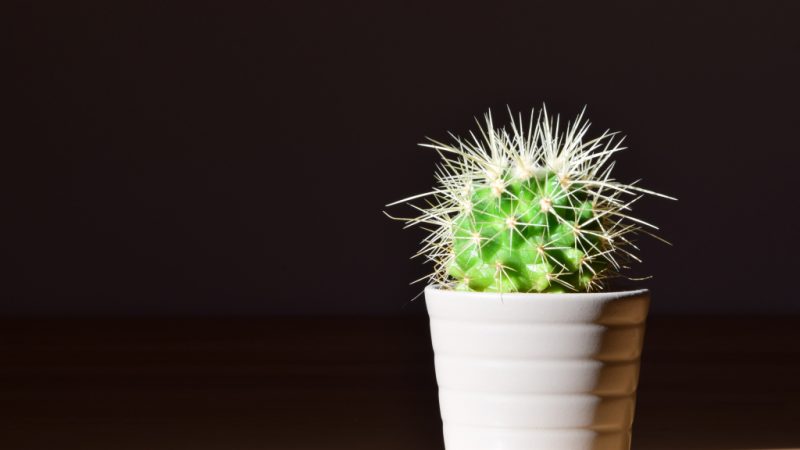
- On hot and sunny days of summer, watering is carried out once a week. If it’s not hot outside, you can water the cactus once every 1.5 weeks.
- The winter period is a hibernation for succulents, so you need to water the cactus once every 2 weeks or even less.
Cactus is not recommended to be watered daily and little by little, like many houseplants. On the contrary, this is how the roots of the succulents lose their air and quickly rot.
Cactus transplant at home
To transplant a succulent, you need to choose the right pot and use a suitable substrate. The container for transplantation is required to choose clay or plastic.Clay dries faster, so it is suitable for adult plants. Rooting will happen better in plastic dishes, since the liquid from it evaporates more slowly.
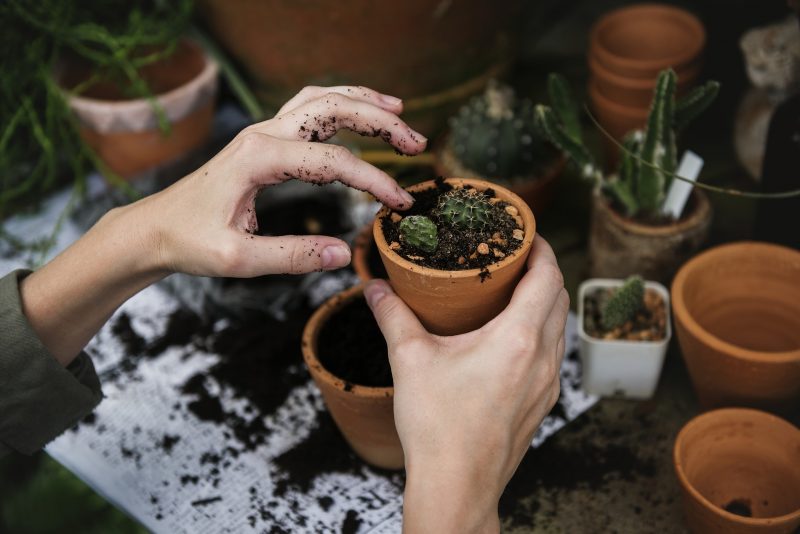
For transplanting, you can purchase special soil for succulents or prepare it yourself.
It consists of the following components:
- sheet earth;
- turf;
- humus;
- coarse river sand;
- charcoal;
- brick crumb.
This composition provides the substrate with friability and good moisture conductivity. Homemade soil must be disinfected in the oven for 10-15 minutes.
Transplanting a cactus is recommended no more than once a year. This should be done after wintering, that is, not earlier than April.
How to transplant succulents correctly:
- For several days you need to completely stop watering. This will ensure a good separation of the root system from the substrate and pot.
- Lay a good drainage layer in a new container at the bottom. They can serve as broken brick chips or any small stones.
- Then comes a layer of charcoal, which will provide disinfection of the root system and soil.
- After this, pour soil into the pot, make a recess in it according to the size of the roots.
- Gently with the help of gloves, grab the cactus by the trunk and separate it from the previous container. Hands can shake off part of the excess land.
- Place the plant in a new pot, sprinkle with earth and flatten.
- Cover the plant with a jar for 3-5 days, and during this period daily water it with a small amount of water.
Proper nutrition and fertilizer
Top dressing must begin after wintering, not earlier than March, and end in the month of September. Use for fertilizer you need only special compounds that are designed specifically for cacti. The usual top dressing for home flowers contains a lot of nitrogen, which harms succulents. Fertilize the soil is required no more than 1 time in two weeks.
How to propagate and plant?
The easiest way to propagate are cuttings. At a certain period, “children” appear on the cactus, from which a new plant can be grown quite easily. They must be carefully separated from the mother trunk with a sharp knife or other suitable object.
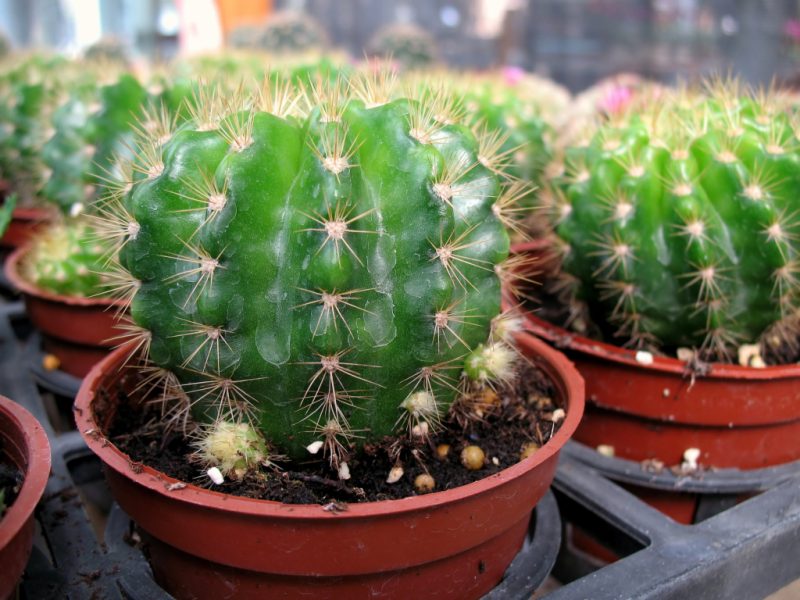
It is recommended to dry the cactus for several days to prevent root decay during rooting. Then you can plant the daughter process in suitable soil. Caring for a small cactus during the rooting period is daily moistening the surface of the substrate with a small amount of water.
Winter cactus care: the nuances
Caring for a cactus in winter includes a few basic rules.

- For succulents, it will be necessary to lower the temperature of the air, and it is also desirable to remove it in a shaded place.
- The temperature in the room should be about 5-15 degrees, but not higher. If there is no way to transfer the flower pot, you need to at least protect it from the battery with the help of a protective structure. It can be built independently from a glass sheet.
- Watering is reduced to 2 times a month, and top dressing is limited completely until March.
With proper care of the cactus, it will certainly bloom and will adorn the interior of any home with its appearance. This succulent blooms with beautiful buds, but the grower will have to try to enjoy this amazing sight.












